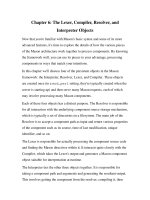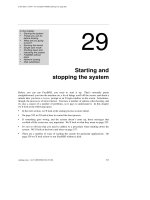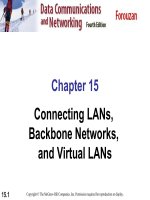Chapter 15 Polymorphism and Virtual Functions doc
Bạn đang xem bản rút gọn của tài liệu. Xem và tải ngay bản đầy đủ của tài liệu tại đây (276.96 KB, 37 trang )
Chapter 15
Polymorphism
and Virtual
Functions
Copyright © 2006 Pearson Addison-
Wesley. All rights reserved.
15-2
Learning Objectives
♦
Virtual Function Basics
♦
Late binding
♦
Implementing virtual functions
♦
When to use a virtual function
♦
Abstract classes and pure virtual functions
♦
Pointers and Virtual Functions
♦
Extended type compatibility
♦
Downcasting and upcasting
♦
C++ "under the hood" with virtual functions
Copyright © 2006 Pearson Addison-
Wesley. All rights reserved.
15-3
Virtual Function Basics
♦
Polymorphism
♦
Associating many meanings to one function
♦
Virtual functions provide this capability
♦
Fundamental principle of object-oriented
programming!
♦
Virtual
♦
Existing in "essence" though not in fact
♦
Virtual Function
♦
Can be "used" before it’s "defined"
Copyright © 2006 Pearson Addison-
Wesley. All rights reserved.
15-4
Figures Example
♦
Best explained by example:
♦
Classes for several kinds of figures
♦
Rectangles, circles, ovals, etc.
♦
Each figure an object of different class
♦
Rectangle data: height, width, center point
♦
Circle data: center point, radius
♦
All derive from one parent-class: Figure
♦
Require function: draw()
♦
Different instructions for each figure
Copyright © 2006 Pearson Addison-
Wesley. All rights reserved.
15-5
Figures Example 2
♦
Each class needs different draw function
♦
Can be called "draw" in each class, so:
Rectangle r;
Circle c;
r.draw(); //Calls Rectangle class’s draw
c.draw(); //Calls Circle class’s draw
♦
Nothing new here yet…
Copyright © 2006 Pearson Addison-
Wesley. All rights reserved.
15-6
Figures Example: center()
♦
Parent class Figure contains functions
that apply to "all" figures; consider:
center(): moves a figure to center of screen
♦
Erases 1
st
, then re-draws
♦
So Figure::center() would use function draw()
to re-draw
♦
Complications!
♦
Which draw() function?
♦
From which class?
Copyright © 2006 Pearson Addison-
Wesley. All rights reserved.
15-7
Figures Example: New Figure
♦
Consider new kind of figure comes along:
Triangle class
derived from Figure class
♦
Function center() inherited from Figure
♦
Will it work for triangles?
♦
It uses draw(), which is different for each figure!
♦
It will use Figure::draw() won’t work for triangles
♦
Want inherited function center() to use function
Triangle::draw() NOT function Figure::draw()
♦
But class Triangle wasn’t even WRITTEN when
Figure::center() was! Doesn’t know "triangles"!
Copyright © 2006 Pearson Addison-
Wesley. All rights reserved.
15-8
Figures Example: Virtual!
♦
Virtual functions are the answer
♦
Tells compiler:
♦
"Don’t know how function is implemented"
♦
"Wait until used in program"
♦
"Then get implementation from object
instance"
♦
Called late binding or dynamic binding
♦
Virtual functions implement late binding
Copyright © 2006 Pearson Addison-
Wesley. All rights reserved.
15-9
Virtual Functions: Another Example
♦
Bigger example best to demonstrate
♦
Record-keeping program for automotive
parts store
♦
Track sales
♦
Don’t know all sales yet
♦
1
st
only regular retail sales
♦
Later: Discount sales, mail-order, etc.
♦
Depend on other factors besides just price, tax
Copyright © 2006 Pearson Addison-
Wesley. All rights reserved.
15-10
Virtual Functions: Auto Parts
♦
Program must:
♦
Compute daily gross sales
♦
Calculate largest/smallest sales of day
♦
Perhaps average sale for day
♦
All come from individual bills
♦
But many functions for computing bills will
be added "later"!
♦
When different types of sales added!
♦
So function for "computing a bill" will
be virtual!
Copyright © 2006 Pearson Addison-
Wesley. All rights reserved.
15-11
Class Sale Definition
♦
class Sale
{
public:
Sale();
Sale(double thePrice);
double getPrice() const;
virtual double bill() const;
double savings(const Sale& other) const;
private:
double price;
};
Copyright © 2006 Pearson Addison-
Wesley. All rights reserved.
15-12
Member Functions
savings and operator <
♦
double Sale::savings(const Sale& other) const
{
return (bill() – other.bill());
}
♦
bool operator < ( const Sale& first,
const Sale& second)
{
return (first.bill() < second.bill());
}
♦
Notice BOTH use member function bill()!
Copyright © 2006 Pearson Addison-
Wesley. All rights reserved.
15-13
Class Sale
♦
Represents sales of single item with no
added discounts or charges.
♦
Notice reserved word "virtual" in
declaration of member function bill
♦
Impact: Later, derived classes of Sale can
define THEIR versions of function bill
♦
Other member functions of Sale will use
version based on object of derived class!
♦
They won’t automatically use Sale’s version!
Copyright © 2006 Pearson Addison-
Wesley. All rights reserved.
15-14
Derived Class DiscountSale Defined
♦
class DiscountSale : public Sale
{
public:
DiscountSale();
DiscountSale( double thePrice,
double the Discount);
double getDiscount() const;
void setDiscount(double newDiscount);
double bill() const;
private:
double discount;
};
Copyright © 2006 Pearson Addison-
Wesley. All rights reserved.
15-15
DiscountSale’s Implementation
of bill()
♦
double DiscountSale::bill() const
{
double fraction = discount/100;
return (1 – fraction)*getPrice();
}
♦
Qualifier "virtual" does not go in actual
function definition
♦
"Automatically" virtual in derived class
♦
Declaration (in interface) not required to have
"virtual" keyword either (but usually does)
Copyright © 2006 Pearson Addison-
Wesley. All rights reserved.
15-16
DiscountSale’s Implementation
of bill()
♦
Virtual function in base class:
♦
"Automatically" virtual in derived class
♦
Derived class declaration (in interface)
♦
Not required to have "virtual" keyword
♦
But typically included anyway,
for readability
Copyright © 2006 Pearson Addison-
Wesley. All rights reserved.
15-17
Derived Class DiscountSale
♦
DiscountSale’s member function bill()
implemented differently than Sale’s
♦
Particular to "discounts"
♦
Member functions savings and "<"
♦
Will use this definition of bill() for all objects
of DiscountSale class!
♦
Instead of "defaulting" to version defined in
Sales class!
Copyright © 2006 Pearson Addison-
Wesley. All rights reserved.
15-18
Virtual: Wow!
♦
Recall class Sale written long before
derived class DiscountSale
♦
Members savings and "<" compiled before
even had ideas of a DiscountSale class
♦
Yet in a call like:
DiscountSale d1, d2;
d1.savings(d2);
♦
Call in savings() to function bill() knows to
use definition of bill() from DiscountSale class
♦
Powerful!
Copyright © 2006 Pearson Addison-
Wesley. All rights reserved.
15-19
Virtual: How?
♦
To write C++ programs:
♦
Assume it happens by "magic"!
♦
But explanation involves late binding
♦
Virtual functions implement late binding
♦
Tells compiler to "wait" until function is used in
program
♦
Decide which definition to use based on
calling object
♦
Very important OOP principle!
Copyright © 2006 Pearson Addison-
Wesley. All rights reserved.
15-20
Overriding
♦
Virtual function definition changed in a
derived class
♦
We say it’s been "overidden"
♦
Similar to redefined
♦
Recall: for standard functions
♦
So:
♦
Virtual functions changed: overridden
♦
Non-virtual functions changed: redefined
Copyright © 2006 Pearson Addison-
Wesley. All rights reserved.
15-21
Virtual Functions: Why Not All?
♦
Clear advantages to virtual functions as
we’ve seen
♦
One major disadvantage: overhead!
♦
Uses more storage
♦
Late binding is "on the fly", so programs run slower
♦
So if virtual functions not needed, should
not be used
Copyright © 2006 Pearson Addison-
Wesley. All rights reserved.
15-22
Pure Virtual Functions
♦
Base class might not have "meaningful"
definition for some of it’s members!
♦
It’s purpose solely for others to derive from
♦
Recall class Figure
♦
All figures are objects of derived classes
♦
Rectangles, circles, triangles, etc.
♦
Class Figure has no idea how to draw!
♦
Make it a pure virtual function:
virtual void draw() = 0;
Copyright © 2006 Pearson Addison-
Wesley. All rights reserved.
15-23
Abstract Base Classes
♦
Pure virtual functions require no definition
♦
Forces all derived classes to define "their
own" version
♦
Class with one or more pure virtual
functions is: abstract base class
♦
Can only be used as base class
♦
No objects can ever be created from it
♦
Since it doesn’t have complete "definitions" of all
it’s members!
♦
If derived class fails to define all pure’s:
♦
It’s an abstract base class too
Copyright © 2006 Pearson Addison-
Wesley. All rights reserved.
15-24
Extended Type Compatibility
♦
Given:
Derived is derived class of Base
♦
Derived objects can be assigned to objects
of type Base
♦
But NOT the other way!
♦
Consider previous example:
♦
A DiscountSale "is a" Sale, but reverse
not true
Copyright © 2006 Pearson Addison-
Wesley. All rights reserved.
15-25
Extended Type
Compatibility Example
♦
class Pet
{
public:
string name;
virtual void print() const;
};
class Dog : public Pet
{
public:
string breed;
virtual void print() const;
};









